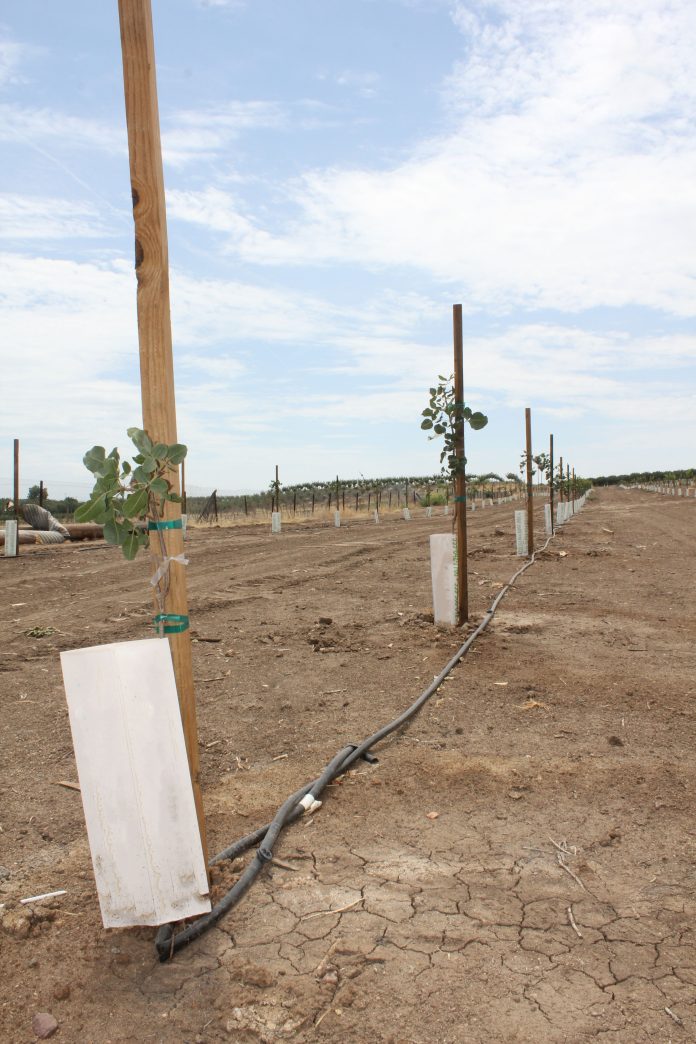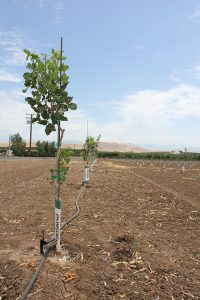
Decisions to plant new pistachio orchards in California’s Central Valley often come down to three words: returns, resiliency and region. Research efforts are part of the picture to help make those new orchards profitable, particularly as they go into less-than-ideal ground.
“Everyone wants their land to be productive with a good economic return,” said Bob Klein, manager of the California Pistachio Research Board.
Returns is the obvious reason new pistachio orchards continue to be planted, said Zack Raven, grower services manager for Keenan Farms. The increase in pistachio plantings in recent years has the industry on target to increase production by 50% by 2027. Investment in land, trees and irrigation systems is being made with grower expectations of profitable returns. Pistachios are being viewed as a profitable tree nut crop, but, besides good returns, there are other considerations spurring pistachio production forward.
Costs a Consideration
Available capital to develop a new orchard is a critical consideration, Klein said, as pistachio orchard development costs are higher than other tree nut orchard development costs. Pistachios have a much longer juvenile period than almonds, and the training costs during that time are higher overall than almonds. Almonds begin bearing in two to three years, pistachios in five to six, adding three years of establishment costs.
Klein said that due to the harvest equipment needed, pistachio growers are almost forced into using custom harvest operations, and many of those harvesters don’t want to harvest blocks smaller than 60 to 80 acres because of the transport costs. So, an almond grower can put in a 10-acre orchard and not worry about harvest, but a pistachio grower has to put in a 60-acre-or-larger orchard to make sure equipment is available for harvest. Cost per acre is greater due to juvenile period and total cost is greater due to minimum orchard size.
Another reason for choosing to plant pistachios, Raven said, is that the mature trees are very resilient in challenging environments. The trees can be planted in soils that would not support growth in other tree nuts, and they can produce a crop.
Tolerance Is a Plus
Mae Culumber, UCCE nut crops advisor in Fresno County, said that pistachio trees are salt-tolerant, with a higher threshold than other nut trees. Proper nutrition as well as monitoring the soil and irrigation water are key to keeping them productive, she said. Tree sensitivity does increase over time.
Aside from salt tolerance, it is pistachio trees’ water use that attracts growers.
Richard Matoian, president of American Pistachio Growers, said that it appears that water availability, either through drought, Endangered Species Act limitations on water movement in the state or implementation of the Sustainable Groundwater Management Act, requires growers to think carefully about what they plant. Because pistachio trees do not require as much water compared to other commodities, and because they will continue to produce crops with less irrigation or with deficit irrigation, it is a crop that many growers consider, Matoian said, especially existing almond growers who have limited water supplies.
Klein said if a given area does not have access to reliable surface water but can pump enough groundwater, high-cash-value crops are critical to afford the well and pumping costs. Raising most row crops with pumping costs reaching $1,000 to $5,000 an acre-foot is not practical.
Newly planted pistachio trees use less water than almond trees during the first few years. Klein and Matoian said that this lower water need can be a significant factor in a decision to plant as SGMA implementation occurs. How much less water, however, is dependent on soil type and if there is a need for leaching fraction due to saline conditions.
Region Affects Maturity
Increase in pistachio acres planted north of Sacramento is being driven by two factors, said UCCE Farm Advisor Katherine Jarvis-Shean.
Some parts of this northern growing region, particularly in Yolo County, are known for higher boron levels in the water and soil, which pistachio trees favor while the condition negatively affects almonds. Growers who already have land in this area, Jarvis-Shean said, are finding better economic returns with pistachios.
The crop is still competing with almonds in new acreage, she said, but as SGMA restrictions on groundwater pumping come into play, even in the north, pistachios may make more sense. Some acreage, she noted, is being planted in heavier, former rice ground and without suitable rootstocks, which she would not recommend.
She noted that northern growing regions also do not have as many degree days needed for nut development. Warm temperatures drive shell split, and the number of hours dictates kernel size. The result, she said, can also be lower split percentage. The earlier maturing Golden Hills variety, which has a higher split percentage, is often the choice when planting in that region.
Processing capacity for the upcoming larger pistachio crop is a concern, said Jeff Gibbons, plant manager for Setton Pistachio of Terra Bella, but the industry can make it work. Pistachio processors handled 1.2 billion pounds of pistachio nuts last year. The 35-day harvest averaged 34 million pounds processed per day. Adding another 100 million pounds in the next five years with the same processing capacity will add another three days of processing, he said. Expansion of earlier maturing pistachio varieties will also help as there would be less incoming crop at the end. Growers like to wait and get their crop off with one shake, Gibbons noted, and that if too many try this, there are processing challenges.
Although pistachios have been considered the ‘new kids on the block’ compared to almond and walnut production, which have benefited from decades of research in production methods, pistachio research has ramped up. The marketing order, California Pistachio Research Board, funded by assessments on pistachio production, lists numerous research projects that are underway.
Research projects for 2022 include production of sterile navel orangeworm to improve management and prevent crop damage, strategies for saline irrigation, rootstock development and genetic improvements.











